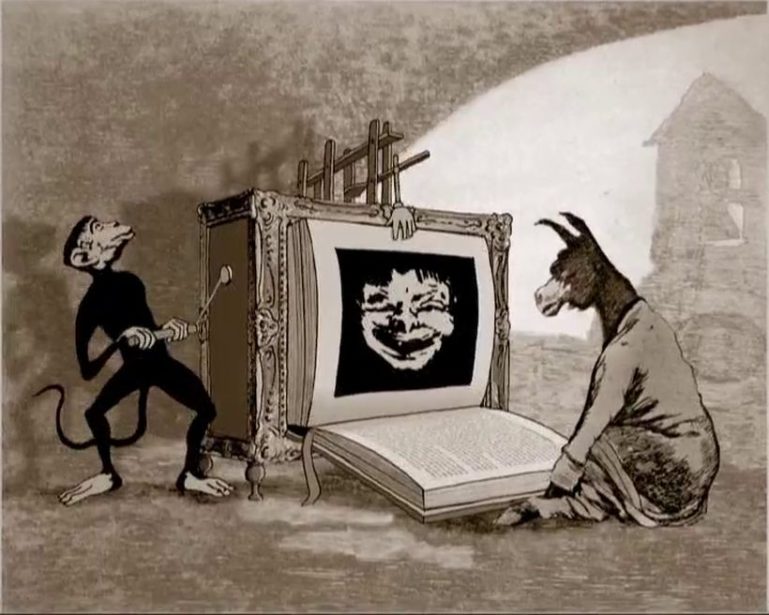“What we’re doing is film research”

YO LO VI © Hanna Nordholt/Fritz Steingrobe
In this first issue of Filmmakers portraits we would like to introduce two of the most ambitous and by now best-known short-film makers in Germany: Hanna Nordholt and Fritz Steingrobe.
This creative duo from Hamburg has been making short films for almost 20 years. It all started in 1984, when they first played around with a Super 8 camera and ended up creating an animated film from a series of pictures in a dance school manual. They went on to find inspiration not only on Hamburg’s experimental film scene, where they themselves are today prominent figures, but also by exploring what other filmmakers were up to. And the best way to do that is of course at the cinema: “Our favourite cinema was the ‘Alabama’ at the western outskirts of Hamburg. Once a month there was a performance by a garage band followed by a fringe film like ‘Texas Chainsaw Massacre’ or underground classics like the early films of John Waters. We were really impressed by the enthusiasm of the John Waters fans we met there. We started making animated and trash films and two or three years later the experimental group ‘Schmelz Dahin’ taught us how to develop our own films. This made us almost completely self-sufficient, with no need for a film lab or duplication service, or the like.”
Early on, Nordholt and Steingrobe decided to focus on animated film as their preferred medium for expressing their artistic ambitions. They incorporate found audio and video material into their own 2-D and 3-D animations, and in recent years have started using computer animations as well. Advancing slowly, “frame by frame”, their films take on an experimental flavour, although precedents can also be found in scientific and military/industrial research – in the methodology of breaking down processes into individual images in order to glean new findings. “We like scientific films, love experimental films and can’t really be pigeonholed. What we’re doing is film research.”
Their films rarely make use of classic narrative structures, but primarily take an associative approach, weaving various levels (of meaning) and thereby opening up unusual perspectives on complex relationships. Dexterously balancing playfulness and gravity, they point up interrelationships between art, society and politics. They cull their source material both from literature, for example the work of William S. Burroughs or Thomas Pynchon, as well as from modern cultural philosophers like Paul Virilio or Friedrich Kittler.
Nordholt / Steingrobe have been frequent guests on the international festival circuit for several years now. One of their major successes was the 16mm film “Das dritte Fenster” (“The Third Window”), inspired by Paul Virilio’s essay “War and Cinema”. The film, which recounts the parallel development of cinematic machinery and military technology by assessing images of lizards, was a competition candidate at many prestigious animated and short-film festivals. This was the first of their films created partly with the aid of a computer. All of the computer-generated images were printed out, arranged on a light-table and shot with a Bolex camera.
Their most recent film, “Yo Lo Vi”, is also the two filmmakers’ most elaborate work to date. In a collage made up of film quotes, a wide variety of animation techniques, symbolic images, and works by Francisco de Goya, they attempt an extraordinarily close-range analysis of the Spanish artist’s graphic work.
Despite the enormous amount of work that goes into a film such as “Yo Lo Vi”, Hanna Nordholt and Fritz Steingrobe work to a large extent autonomously, taking their films from initial idea through animation to post-production without external assistance. “Back in the beginning we had a group of people all working together on our films, but through the years the group dwindled until it was just us two. Our films are now made under very intimate, even monkish conditions, which you could hardly impose on a third person. But now we’re interested in working with a sound specialist again and are looking forward to what this will bring. We produce our films ourselves in order to maintain total control of all aspects.” But whereas Germany’s auteur and experimental filmmakers are increasingly setting their sights on the museum context, Nordholt / Steingrobe have from the outset concentrated on promoting their films through festivals. “Yo Lo Vi” for example has been shown at over 50 short film festivals, often accompanied by the two filmmakers themselves. They claim that festivals represent the most important source of inspiration for their work: “Almost everything we know about films, we learned at festivals.”
Last year, their international festival profile finally bore fruit back on their own turf. “Yo Lo Vi” was nominated for the 2003 German Short Film Award. And their next project is already in the works: after the success of “Yo Lo Vi”, Hanna Nordholt and Fritz Steingrobe are now producing a new experimental short film called “Drei Grazien (50.000 €)” (“Three Graces – 50,000 €). As they tell it, the film is about “human-machine couplings and how these connections affected creative processes and artistic output in the 20th century.” That’s what you call continuity.
Filmography
21-Neue Botschaften auf der Delta-Frequenz Super 8, 1984, 8min.
Die Konsequenz in der Herrenmode Super 8, 1985, 5min.
Wahlkreis 209 Super 8, 1987, 4min,
Bi Mekaar Super 8, 1988, 5min.
Situation Normal Super 8, 1988, 6min.
Interview Super 8+35mm, 1989, 4min.
Bei Ruth Super 8, 1989, 8min.
Möchte jemand einen Keks? Super 8+35mm, 1990, 4min.
Gloria Super 8, 1990, 8min.
Radio Radio Super 8, 1991, 6min.
Headquarter Super 8+16mm, 1992, 14min.
Schraube Super 8, 1993, 7min.
Prawda Super 8, 1993, 6min.
350 Z 35mm, 1994, 1min.
Das dritte Fenster 16mm, 1997, 17min.
Turtle Funk Beta SP, 1998, 4min.
Love Bugs Beta SP, 1999, 4min.
Netrats Beta SP, 2001, 5min.
Pa Tak Mini DV, 2002, 4min.
Yo Lo Vi 16+35mm, 2003, 15min.
Drei Grazien (in production)
(mj)